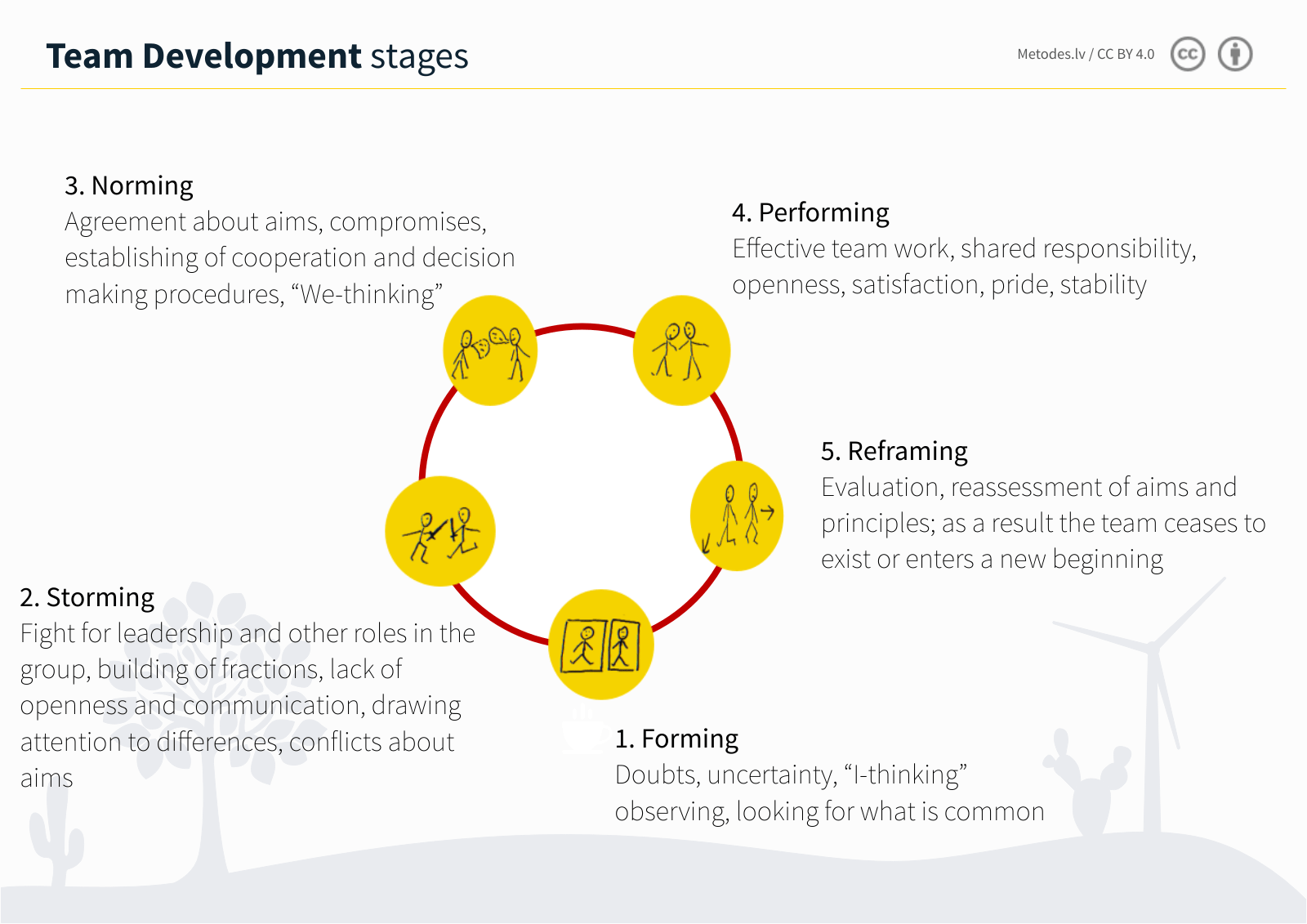Group dynamics theory teaches that each group experiences various different stages of development. There is no guarantee that a group will reach the next development stage and the length of time a group remains in a particular stage varies from group to group and stage to stage. The group development process is not linear: a group that has reached the 3rd or 4th stage can easily fall back into the “Storming” stage. A group might skip a stage, but this will haunt the group later in the process; in order to reach the “Performance” stage the previous stages have to be successfully concluded first.
Based on the work of Bruce Tuckman, Peter R. Wellhöfer and Eberhard Stahl, as well as our own experience in conducting team trainings, the following list summarises the group development stages and actions that the leader can undertake to help the group reach the next level.

1. Forming

In this stage group members are very much occupied with their own emotions and doubts: uncertainty about whether they will find their place in the group, what will the other participants be like, what to expect from the teacher, etc. “I-thinking” is the predominant attitude. In their search for safety and structure, the group members try to become oriented, look for a safe place, search for sympathetic colleagues, and expect help from the leader.
The leader must look assured and exude certainty in order to help group members find their places. The teacher should create a positive atmosphere and provide space for communication and interaction.
2. Storming

Participants try to find their place in the group. There are many discussions, coalitions are made to represent one’s interests, and there is lots of competition. Many people talking at the same time and nobody listening to each other is a clear indicator that the group is in the Storming stage. Failure or success in this stage will to a large extent determine how open or closed participants will be later in the process and how well they deal with conflicts and emotions.
The leader can guide the group through this stage by giving the group practical tasks that help to establish relationships and clarify roles. The teacher should show confidence and leadership because this stage can get rather emotional. All participants’ contributions should be dealt with equally.
3. Norming

Participants have established principles and procedures for achieving results and creating a positive atmosphere. Participants have found their place and feel safe in the group. People feel a part of the group, “I-thinking” is replaced by “We-thinking”. It has become easier to communicate and collaborate with each other.
The leader can entrust the group with more challenging and demanding tasks. The teacher should find a balance between the group’s human and task-related interests, e.g. the wish to communicate with each other and the requirements of the curricula.
4. Performing

This is the highest point a group can accomplish. The result is similar to two people being in love: participants feel proud to belong to this group, they have a strong belief that nothing is too difficult for them, and interaction is based on complete trust and openness. Objectively, such a group is also highly productive. Most groups never reach this stage because it requires strong motivation, common goals, great emotional input, and strong commitment from the participants.
If a group has reached this stage, the leader can step aside and limit his/her role in facilitating the process, thus further strengthening the group’s ability to work autonomously. He/she might want to present the group with new perspectives in order to provide the group with further opportunities to develop.
5. Adjourning (Reframing)

This is the highest point a group can accomplish. The result is similar to two people being in love: participants feel proud to belong to this group, they have a strong belief that nothing is too difficult for them, and interaction is based on complete trust and openness. Objectively, such a group is also highly productive. Most groups never reach this stage because it requires strong motivation, common goals, great emotional input, and strong commitment from the participants.
If a group has reached this stage, the leader can step aside and limit his/her role in facilitating the process, thus further strengthening the group’s ability to work autonomously. He/she might want to present the group with new perspectives in order to provide the group with further opportunities to develop.
Some things to keep in mind
- The time a group spends in a stage can be minutes or years, and there is no guarentee that it will reach the next level. The more the group members are used to team work and the better the support from the leader, the faster the group will reach the “Performance stage”.
- The group development process is not linear: a group that has reached the 3rd or 4th stage can easily fall back into the “Storming” stage.
- Working in groups does not come naturally to most people and conflicting personal interests versus group interests is a common challenge. Working in groups requires practice.


